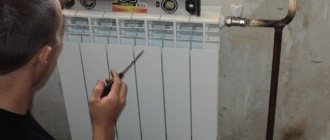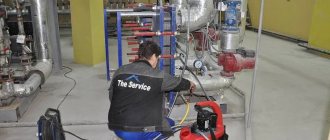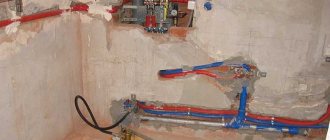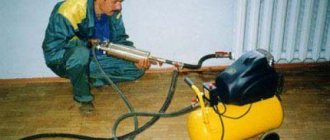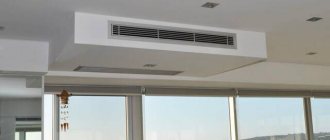There are hundreds of connections in any heating system. This is a connection of pipes and radiators, ball valves, circulation pumps and expansion tanks. In sectional batteries, the weak point is the connection of the sections to each other through a gasket; in the presence of heated floors, additional threaded connections appear between the boiler and the collector and between the collector and the floor heating system.
All these connections are checked after installation, i.e. the heating system is pressurized with air. SNiP clearly and unambiguously stipulates the norms for pressure testing of heating systems. Technically, pressure testing is carried out by creating high air or water pressure in the system to detect defects and coolant leaks.
Pressure testing the system and removing air from the circuit
After completing the installation work to create the heating system, it is disconnected from the boiler, the hermetic expansion tanks are turned off, and in open systems the expansion tanks are sealed. This is how we prepare to check the heating circuit for its functionality. The operation of testing a heating system with high pressure is called pressure testing. It can be carried out either with air or with the help of hydraulic pumps with water.
According to SNiP standards, crimping is mandatory:
- when putting a new system into operation;
- after replacing system elements (risers, batteries, pipes);
- in preparation for the heating season.
In accordance with the rules of SNiP, a crimping test report is drawn up. In newly installed circuits, air pressure testing of the home heating system is most often performed. It is believed that after crimping, if no defects requiring elimination have been identified, then the system is completely ready for operation. After completing the system tests, filling the system with water usually begins. It is very likely that another problem will arise - it will be necessary to bleed air from the heating system, which will inevitably disrupt the operation of the entire circuit.
Air that has entered the heating system disrupts the circulation of the coolant, causes uneven heating of the batteries, and reduces the efficiency of the circuit. The analysis of the causes and the answer to the question of where the air in the heating system comes from is ambiguous. There are many reasons, the main ones:
- violation of installation rules;
- improper filling of the heating system;
- poor sealing of joints, threaded connections and seams;
- hit during repair work;
- malfunction of air vents;
- low pressure in the circuit;
- release of dissolved air from the coolant during heating.
Preparing for work
All measuring equipment must undergo preliminary verification in a licensed testing laboratory. The hydraulic power supply is connected to the pressure line via a test pressure manifold. The manifold has a drain valve and a pressure gauge. Pressure gauges are installed at the end and beginning of the pressure line.
Before starting pipe pressure testing, all valves and valves must be closed.
Preparation for pressure testing of a pipeline includes the following steps:
- Filling the circuit with working fluid;
- Filling the line until a pressure equal to the test pressure is created there;
- Connecting test instruments and equipment to the desired section of the highway.
Air bleeding devices
Air that appears in the circuit for one reason or another must be removed. To bleed air trapped in the system, use a heating air vent, which can be manual or automatic.
Manual air vent
A manual air vent, better known as a Mayevsky tap, is installed only in apartments on heating radiators due to its low throughput. Typically, such valves are installed on all radiators, and they ensure the bleeding of air from the heating system during setup and operation.
Automatic air vent
Automatic float-type air vents operate as follows. If the system is operating in normal mode, the float completely closes the valve opening, but if an air lock occurs in the system, the float opens the valve. The open valve of the automatic air vent releases air from the heating system, then rises again and closes the valve. Of course, the use of automatic air vents facilitates the operation of systems, but they require systematic maintenance and cleaning of various contaminants present in the water.
Signs of air locks
The first sign of air in the system is poor heating of the batteries. The battery warms up unevenly, not enough, and if any sounds appear in it, then the answer is clear - the air in the heating radiators is preventing the circuit from working properly. If the radiators have a bottom connection, and its upper part is cold, then air has accumulated in such a radiator and bleeding the air from the heating radiator will restore normal operation.
Removing air from heating circuits
There is a lot written on the Internet about what needs to be done and how to remove air from a heating battery. For open heating systems with an expansion tank, this problem is not relevant. In such systems, the air exits independently through a tank located at the highest point of the circuit. Problems with some radiators may arise, especially if the slope is chosen incorrectly. Such air bubbles are removed using Mayevsky taps or automatic air vents.
For closed systems with forced circulation, the problem of how to get rid of air in the heating system is also completely solvable. Air is removed from the batteries manually by opening the Mayevsky tap. If you hear a hissing sound when you open it, then the actions are correct and there is air in the system. The air must be released until water appears at the outlet of the Mayevsky tap.
The most dangerous air locks are at bends and turns of pipelines.
Such accumulations of air can completely stop the circulation of water in the system. If the installation of problematic areas of the circuit, for some reason, cannot be changed, then a heating system air bleed valve is installed in such problematic areas to bleed it.
Features of aluminum radiators
An unpleasant phenomenon is sometimes observed in aluminum radiators. The radiator material reacts with water. As a result, gases are constantly formed and must be constantly removed from the radiator, and how to remove air from a heating battery is described above. To avoid the problem described above, it is enough to buy and install aluminum radiators with an internal anti-corrosion coating. The correct solution would be to replace the aluminum radiator with a bimetallic one.
Sequence of air removal in high-rise buildings
For multi-storey buildings, the problem of when and how to properly bleed air from the heating system is solved as follows. Air usually rises and accumulates in radiators and piping on upper floors. But before the heating season, checking and removing air must be done sequentially, starting from the lower floors.
If you install an automatic air vent for heating radiators on the heating radiator and in problem areas, it will ensure air bleed. Of course, you can check the system manually, it won’t make you worse, because... the valve may become dirty or stuck, which will prevent the automatic release of air from the heating system and disrupt the operation of the circuit.
Mechanisms for carrying out
Crimping operators, i.e. Special pumps for carrying out relevant tests differ in design. Based on this feature, they are classified into three types:
- Porshnev.
- Vane-rotor.
- Membrane.
If testing of a pipeline (or other object) of a relatively small volume is required (for example, in private housing construction), then it can be performed using an inexpensive and easy-to-maintain manual pressure tester. This mechanism allows you to pump up to three liters of working fluid into the system in a minute.
To check the systems of a multi-story building, you will need a more powerful mechanism driven by an internal combustion engine or electric. The domestic UGO-30 is equipped with a 16-liter tank and allows you to develop a pressure of up to 30 atm. Manual two-stage pumps UGO-50 and UGO-450 are used when performing more complex tasks.
In domestic conditions, compact devices are used that can be manually controlled.
German-assembled electrically driven crimpers produced by Rothenberger (model ROTEST GW 150/4, for example, designed for testing drinking water and gas supply systems with air) and Ridgid (for example, model 1460-E 19021 are used in systems filled with as a working fluid water, oil or ethylene glycol).
Air separator, what is it?
Air separators or their other name - air collectors for heating systems are designed to remove air from the coolant that circulates in the circuit. It is used for systems of any type, in underfloor heating systems and in heat pumps. Water is passed through a separator to remove dissolved gases and various contaminants that adversely affect the system and contaminate various valves. An air separator makes the question of how to properly remove air from a heating system completely irrelevant. But to increase the reliability and durability of the system, a separator and manual or automatic air vents are installed in the heating system of a home or business.
Air separators have many useful properties that improve heating circuits:
- installing a separator improves heat transfer;
- high reliability due to the extreme simplicity of the design;
- significant improvement in water quality in the circuit;
- cleaning of accumulated contaminants can be done without stopping the system;
- low cost and ease of installation;
- removal of the smallest particles of dirt from the coolant.
Consequently, the answer to the popular question - how to bleed air from the heating system - is simplified. There will be so little air in the system that tiny traces of it can be easily removed manually. For this purpose, Mayevsky taps and automatic air vents are used. There is a fundamental difference between manual and automatic air vents. The Mayevsky crane removes, for example, air pockets that have accumulated at the highest points.
The separator extracts the air dissolved in the water and removes it.
That is, when heating the water that has passed through the separator, no air will be released. Of course, using a separator for small systems is expensive; removing air manually can be done easily and simply. Air separators are most widely used in complex, large heating circuits. If you decide to buy an air separator for heating, the price will depend on the performance, ranging from 3,000 to 40,000 rubles.
Price
The cost of crimping depends on several factors:
- length (internal volume) of the system;
- the age of the system and the condition of its constituent elements (amount of rust and dirt and salt deposits);
- type of equipment used.
Prices from different performers, even within the same city, may differ by 2–3 times. Private teams and craftsmen charge the cheapest for their services.
On average, for flushing and pressure testing the heating system of a building with an area of 400 sq. m (two-story) performers charge from 7 to 15 thousand rubles. As practice has shown, if you know how to bargain, you can agree to complete this amount of work for 4–5 thousand rubles. The work will be completed in 1 – 2 days.
The same work in a building of 5 thousand square meters. m (5 floors) will cost from 30 to 80 thousand rubles.
Some performers indicate prices per unit of volume (150 - 250 rubles / cubic meter) or time (500 - 1000 rubles / hour).
What to do if the system does not work?
It may happen that the most careful removal of air plugs, installation of automatic air vents and even a separator does not bring the desired results. After some time, the system begins to work poorly, air pockets appear, which need to be removed again and again. In this case, only pressure testing of the heating system will help. SNiP clearly defines the procedure and methods of verification. Pressure testing will help to find places where air is leaking, lack of tightness of fittings and circuit connections and other shortcomings. After careful pressure testing, heating systems usually operate for a long time and reliably.
